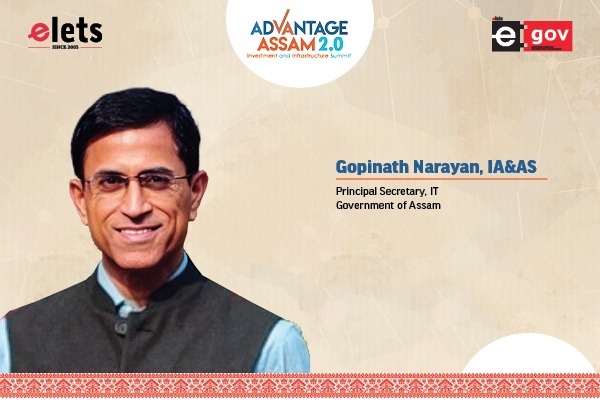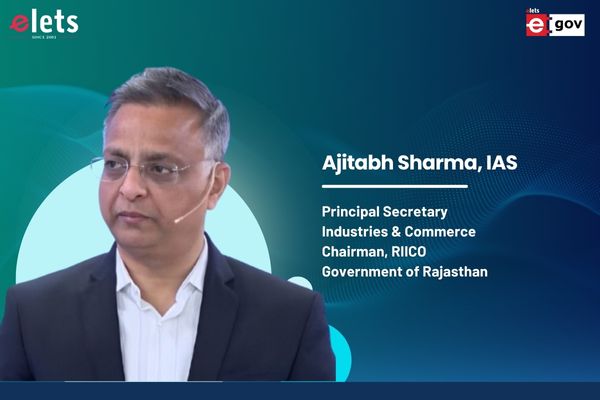
Energy security and sustainability in India are crucial imperatives as the nation navigates its dynamic economic growth. India has been steadily diversifying its energy mix, emphasising renewable sources such as solar and wind power. Policy frameworks and initiatives have also been prioritised to enhance energy efficiency, promote electric mobility, and expand access to clean cooking fuels, shares Rajnath Ram, Advisor (Power & Energy), NITI Aayog, in conversation with Nisha Samant.
What are the key strategies to ensure energy security and sustainability in India? How is the government promoting renewable energy adoption, and what progress has been made?

India is among the few countries successfully managing the emerging trilemma (energy affordability & access, energy security and sustainability) despite global economic turbulence and rising energy costs. India has connected all households to electricity and is now taking active measures to improve the quality of the power supply. The electricity tariffs in India are kept stable by the Government, significantly when the prices rose worldwide, especially in Europe due to the Russia-Ukraine conflict. The residential electricity tariffs in India are kept reasonably low at $ 0.07/KWh compared to $0.52/KWh in Germany and $0.18/KWh in the United States to meet our developmental aspirations of a growing economy and ensuring access to clean cooking fuels to citizens through the government programs. Under Pradhan Mantri’s Ujjwala Yojana (PMUY), the Government has provided access to 96 million targeted households. An additional 7.5 million connections have been targeted under the scheme to reach a target of 103.5 million connections by 2025-26. As a result of several pro-poor measures taken by our government, we have already lifted 248.2 million people out of multi- dimensional poverty during 2013-14 and 2022-23.

In the context of energy security, India has been consistently diversifying its resources through increased adoption of renewables/ clean fuels through mandates such as ethanol blending and CBG blending, increased domestic production and exploration, increased demand electrification and promotion of various energy efficiency measures. The recently launched Production Linked Incentive (PLI) schemes aim to strengthen domestic manufacturing capacities in high-efficiency solar cells and modules and advance chemistry cell manufacturing.

India is amongst the best-performing countries in Climate Change Performance Index (CCPI 2023) and is best among the G-20 nations. India ranks 3rd in the world regarding installed renewable energy capacity, and its share of non-fossil power capacity in total installed capacity will reach 43.7% by Dec 2023. India has already created a carbon sink of about 1.97 billion tonnes through various sustainable afforestation initiatives.

Are there any specific policies or initiatives to reduce India’s carbon footprint and combat climate change within the energy sector? How does the government balance the exploitation of natural resources with conservation efforts to ensure sustainable development? What measures are being taken to address deforestation, soil erosion, and water scarcity?
India has adopted very ambitious decarbonisation strategies even though its share in historical emissions (1890-2021) in global emissions is less than 5%, while the share of the US is 25% and China is 14%. India’s developmental trajectory reflects its low energy consumption and low emissions, even with its decoupling beginning at much lower emission levels. India’s updated NDC targets include: i) increasing the non-fossil share to 50% by 2030, ii) reducing the emission intensity to GDP by 45% over 2005, and iii) increasing carbon sink to 2.5-3 billion tonnes by 2030. The various initiatives taken by the Government to push forward India’s low-carbon transition agenda include decarbonising.
The Electricity Grid: Notification of RPO obligations wherein each state is mandated to meet 43.3% of its demand in 2030 from renewable sources. Besides RPO notification, the Government of India has also announced several measures such as Production Linked Incentive Scheme in High-efficiency solar PV modules, Waiver of inter-state transmission charges, Green Open Access rules, Standardized bidding guidelines, Creation of Green Day Ahead Market (GDAM) and Green Term Ahead Market (GTAM), Centralized procurement, Simplified procedure on rooftop solar, Solar Parks, Green Energy Corridor, and 100% FDI under automatic route.
Bidding Calendar: The Ministry of New and Renewable Energy (MNRE) has recently notified a bidding calendar wherein it has proposed to enhance the annual addition capacity. This will signal the government’s commitment towards achieving the net-zero target for the market.
As mentioned earlier, the bids for the trajectory may consist of solar, wind, solar-wind hybrid, round-the-clock renewable energy power, with or without storage, or any other combination with an annual target of 50 GW. MNRE has also notified the bidding plan separately for offshore wind, wherein it intends to add 37 GW by 2030.
Green Hydrogen: The Government of India has announced a Green Hydrogen Mission to produce 5 MMT of Green Hydrogen by 2030. Green Hydrogen Mission aims to decarbonise refineries and the fertiliser sector in the short run and other hard-to-abate industries such as Steel and Heavy-duty transport in the long run. The mission will provide financial incentives to electrolyser manufacturing and green hydrogen production.
Energy Storage: Govt of India has approved a viability gap funding scheme to install 4000 MWh storage capacity. Central Electricity Authority has also notified guidelines for pumped storage projects.
Agriculture Sector’s Solarisation: The PM KUSUM scheme launched in 2019 is one of the world’s most significant clean energy initiatives in the agriculture sector to solarise agriculture pumps of almost 3.5 million farmers. Many states in India today have dedicated agriculture feeders that allow system operators to control agricultural users directly without affecting other users. An energy data management platform that facilitates real-time optimises energy use. The schedule is being scaled to minimise energy use.
Ethanol and CBG blending: Target of 20% ethanol blending in Petrol is to be achieved by 2025 as opposed to the previous assertion 2030. In the 2023-24 union budget, the government has mandated 5% CBG to be utilised for all entities marketing natural and biogas in India. These two targets will reduce the country’s import bill and emissions in the transportation sector.
GoI is also implementing Faster Adoption and Manufacturing of Electric Vehicles (FAME) to create demand for EVs in the country. Over 2.5 million EVs and 164 models have received support under the scheme. The recent re- modelling of FAME II coupled with the PLI scheme would provide the initial thrust for the uptake of the battery ecosystem in the country. Similarly, 14 states have an EV policy following the same path.
Battery Swapping Model: As an alternative to space constraints in charging infrastructure, the government has formulated a draft Battery Swapping Policy to encourage the private sector to develop an innovative business model for “Battery or Energy as a Service”, especially given the constraint of space in urban areas for setting up charging infrastructure. The Battery swapping policy intends to provide a level playing field to all battery service providers by creating new avenues of investments in innovative business models such as Battery as a Service (BaaS).
Pradhan Mantri Suryodaya Yojana: The scheme aims to facilitate rooftop solar installation among more than 1 Cr households in the country. Through the scheme, one crore households can obtain up to 300 units of free electricity every month with savings of ₹15,000- 18,000 annually.
Carbon Economy: With the recent amendment to the Energy Conservation Act, India is paying the way for the set-up of the domestic carbon market, which will further incentivise the adoption of clean technologies.
Demand Side Measures: On the demand side, India has been at the forefront of promoting energy efficiency through innovative programmes such as the Perform Act Trade (PAT) scheme, Standards & Labeling (S&L), Unnat Jyoti by Affordable LEDs for All (UJALA) scheme, Energy Conservation Building Code (ECBC), Electric Vehicle mission, Smart metering, etc. All these measures already led to the mitigation of about 267 million tonnes of CO2 annually, resulting in INR 1.5 lakh crores of energy savings (BEE Impact Assessment Report, 2021-22). India is encouraging all possible initiatives to add momentum to its call for ‘LIFE – Lifestyle For Environment’, which aims to decouple economic growth from greenhouse gas emissions. G20 Delhi declaration commits to mainstreaming LiFE among member countries– “we commit to robust collective actions that will enable the world to embrace sustainable production and consumption patterns and mainstream Lifestyles for Sustainable Development”.
What are India’s leading environmental protection challenges, and how is NITI Aayog addressing them? How does the government plan to mitigate the impact of pollution on air, water, and soil quality, especially in urban areas?
India is undertaking an unprecedented historical experiment to push forth a development paradigm and decarbonisation. Globally, development has been synonymous with fossil fuel consumption and dependency. When confronted with such a challenge, India sincerely believes in the Principle of “One Earth, One Family and One Future”. As a testimony, “Climate Change Performance Index 2023” places India amongst the top countries globally. India has not only over- achieved one of the 2015 NDCs but has also unleashed its ambitions with the announcement of updated NDCs and submission of the “Long-Term Low Carbon Development Strategy”, laying down the path for achieving the “Panchamrit” goal of net zero emissions by 2070.
We promote adopting sustainable production and consumption systems through Mission LiFE (Lifestyle for Environment). To incentivise the adoption of environmentally friendly lifestyles, we have now brought in the Green Credit program, which incentivises various stakeholders such as individuals, Farmer Producer Organisations, cooperatives, forestry and agriculture enterprises, private sector organisations and industries who will receive Green Credits for environmentally friendly actions which can be traded on the domestic market.
Compared to the global carbon market, where the incentive is only for reduction in GHGs, through Green Credit, the Indian government aims to incentivise a host of other activities such as waste management, water management, sustainable buildings, etc. Participation in the Green Credit programme will be voluntary. However, the Indian government is hopeful that with a concerted global focus on ESG (Environmental, Social and Governance) norms, the experience of the Green Credit program will be central in pushing the adoption of such resilient ESG practices globally as well.
To tackle the problem of air pollution, the National Clean Air Programme (NCAP) has been launched with the goal of a 40% reduction in PM levels by 2030. The government of India has set aside about $1.7 billion to fight air pollution in 42 Indian cities that have million-plus populations. This is the world’s first performance-based fiscal transfer funding program for city air quality management. Other efforts of the government include the notification of National Ambient Air Quality Standards, emission standards, and leapfrogging from BS-IV to BS-VI. They also set up a monitoring network to assess ambient air quality and launched the National Air Quality Index.
How do energy, natural resources, environment, and island development policies intersect to achieve holistic sustainable development goals? What role can technology and innovation play in enhancing the efficiency and effectiveness of policies in these sectors?
According to IMF 2023 estimates, India’s per capita income is USD 2.6 thousand while developed economies have high per-capita income (Japan is USD 33.95 thousand, South Korea USD 33.15 thousand, and the USA is USD 80.41 thousand). To realise the vision of becoming a developed nation, an aspiration given by our Hon’ble PM, India’s energy demand will increase. Energy is needed for social development to support India’s demographic, agricultural and urban transition and infrastructure development. Therefore, Energy needs will grow 2-2.5 times by 2047 to meet a growing economy’s development deficit and aspirations. However, this energy demand growth will be met through Green Growth strategies outlined in India’s Long Term Low Emission Development Strategies (LT-LEDS) document submitted to UNFCCC. Green growth strategies include: i) Non-fossil based electricity installation system ii) Develop an integrated, efficient, inclusive low- carbon transport system iii) Promote adaptation in urban design, energy and material-efficiency in buildings, and sustainable Urbanization iv) Promote economy-wide decoupling of growth from emissions and development of an efficient, innovative low-emission industrial system v) CO2 abatement and related engineering solutions vi) Enhancing forest and vegetation cover consistent with socio-economic and ecological considerations.
Technology and Innovation have very critical roles to play, especially when one becomes conscious of the fact that many technologies that are required for global net zero are not available at a commercial scale today, such as Hydrogen Steel/ Cement, Steel and Aluminum production with CCUS, Small Modular Nuclear Reactors (SMR) etc. Global collaboration and technology transfers will be crucial for fastening innovation and accelerating adoption. Developing countries should mutually agree upon technology transfer, including concessional and preferential terms.
(Disclaimer: the views expressed by the Author are personal)
Be a part of Elets Collaborative Initiatives. Join Us for Upcoming Events and explore business opportunities. Like us on Facebook , connect with us on LinkedIn and follow us on Twitter, Instagram.
"Exciting news! Elets technomedia is now on WhatsApp Channels Subscribe today by clicking the link and stay updated with the latest insights!" Click here!













